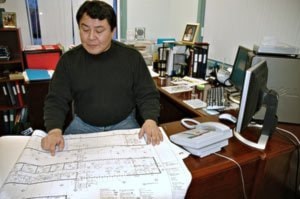The Yukon’s most remote community will soon welcome visitors to its natural and cultural treasures in a more formal way.
The fly-in northern community of 300 plans to open its first visitor reception centre in 2008.
Right now there’s no central point for information on the area, which means most tourists pop into the First Nation office with questions, said Vuntut Gwitchin chief Joe Linklater, while sitting in that office on December 14.
“We give them whatever information we have, but it’s just sort of piecemeal at this point,” he said.
The proposed centre is a joint project of the First Nation, Parks Canada and the Yukon government.
The roughly eight-by-42-metre building will be located across from the Vuntut Gwitchin First Nation band office.
The First Nation wants to make Old Crow the hub and entry point for the natural and cultural wonders in the North Yukon — Vuntut National Park, Old Crow Flats special management area, the Blue Fish Caves, the Fishing Branch, Bear Cave Mountain and various other areas around the community.
Although the new centre is expected to attract more tourists to the region, that’s not its main purpose, said Linklater.
“It’s not designed to draw tourists, but I think it becomes much more convenient and I think people are more and more likely to come.”
So the new centre will also educate visitors on the area’s history, and about how to respect and protect the region’s valuable natural and cultural resources.
Researchers are interested in North Yukon areas, such as Crow Flats, for studying subjects like waterfowl and permafrost, said Linklater.
“So what we’re trying to do is protect these areas and give some certainty to researchers that they can come back year after year and these places will not have been altered in any significant fashion by man-made footprints,” he said.
“People who are interested in these areas come because they generally care about the conservation.”
The centre will also meet one of the commitments of the Vuntut Gwitchin First Nation’s land-claim agreement, said Linklater.
Although the plans are not finalized, space has been marked out for a theatre and a large exhibit area with movable displays that can be rearranged or moved aside to make room for community gatherings.
The building will also house office space for Parks Canada, the Yukon government and the First Nation’s heritage department, said Linklater while unrolling large sheets of blueprints drafted by Kobayashi and Zedda Architects.
“We want it to be very much a community building.
“It’s going to be a visitor reception centre where you can find information out about the North Yukon, but there’s going to be related offices in there where they’re doing research in the areas of heritage and culture and environment,” said Linklater.
It will also act as a spot for people in the community to come and research the area and the culture.
The project began in 1999, and has been moving along slowly since then, said Vuntut National Park superintendent Bob Lewis.
“The park has been described as a gift from the Vuntut Gwitchin to Canadians,” said Lewis.
“It’s land that they’ve managed for thousands and thousands of years, which they’ve given to Canadians in a state that is the most pristine in our system.”
Since Vuntut park is extremely difficult to access, the visitor centre would also have an online component, which would allow people to explore the area through cyberspace.
“Our basic interest is in helping the First Nation there tell their story,” said Yukon Tourism and Culture museums manager Ed Krahn.
The Yukon’s department of Tourism and Culture funded the project’s planning with $60,000 in 2004-05.
It will work with the Environment department, and others, to create exhibits for the centre.
The First Nation is currently working with Parks Canada and the Yukon government to secure and finalize funding to begin construction, which Linklater estimates will cost somewhere between $2.5 and $3 million.
If all goes according to schedule, contractors will start building in the spring of 2007, and the centre will open its doors to the public in 2008.
